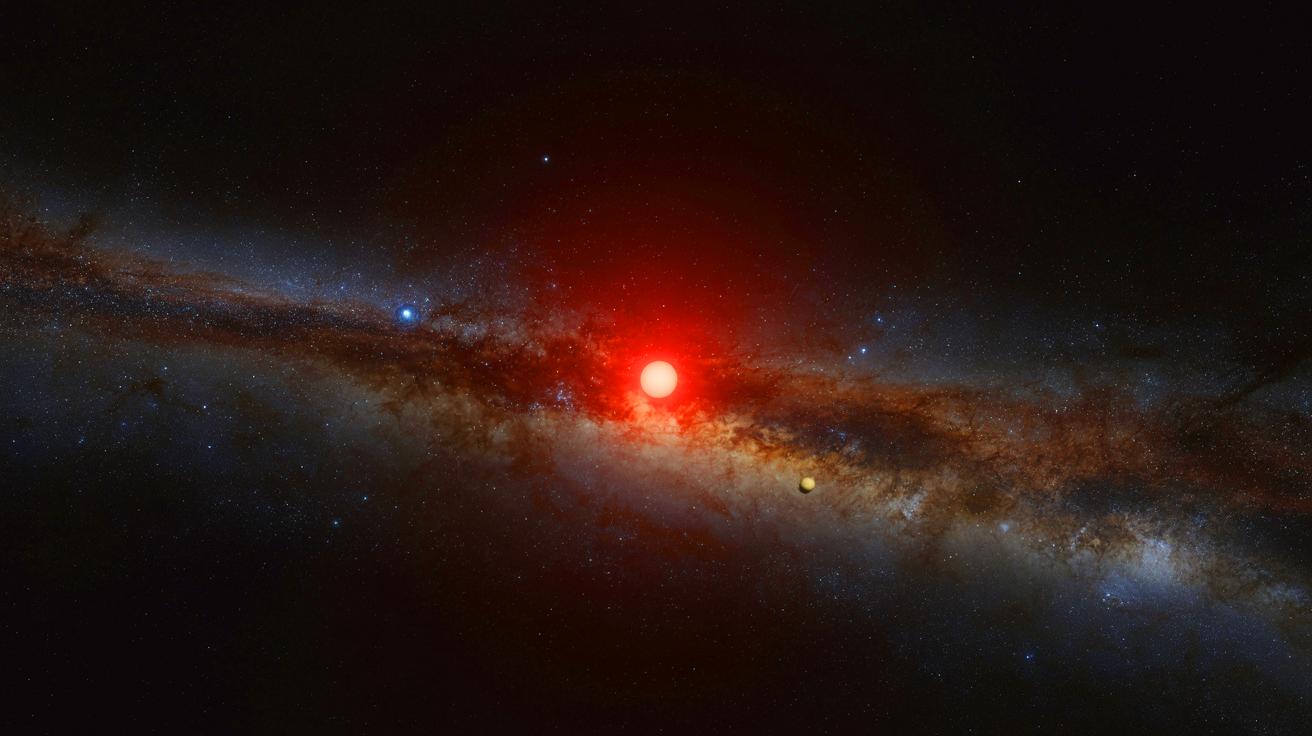- 🌌 AT2021uey b is a massive exoplanet discovered in a metal-poor region of the Milky Way, challenging current planetary formation models.
- 🔍 The planet was detected through the rare phenomenon of gravitational microlensing, a concept rooted in Einstein’s theory of general relativity.
- 📡 The discovery was made possible by data from the Gaia space telescope and confirmed by the Molėtai terrestrial observatory.
- 🌠 This finding suggests a greater diversity of worlds in unexpected environments, opening new avenues for detecting hidden exoplanets.
In the vast, enigmatic stretches of our galaxy, hidden realms whisper secrets beyond the reach of our most advanced telescopes. These are the silent worlds, giant cold planets orbiting distant stars—obscured in shadows, yet brimming with mystery. One such colossal world, named AT2021uey b, has recently unveiled its presence. This discovery owes its revelation to a groundbreaking concept introduced over a century ago by Albert Einstein: the theory of general relativity. This celestial marvel challenges our understanding of planetary formation and invites us to explore the universe’s hidden corners with renewed curiosity.
A Lost Planet at the Edge of the Milky Way
AT2021uey b is an exoplanet, meaning it resides outside our solar system, boasting a mass greater than Jupiter, the largest planet known until now. It leisurely orbits a red dwarf star, a far cooler and dimmer counterpart to our Sun. This massive planet takes over 11 years to complete a single orbit, indicating its vast distance from its host star. What makes AT2021uey b truly fascinating is not just its size or slow orbit but its unexpected location.
Nestled in a peripheral region of the Milky Way, this area is often described as metal-poor, meaning it lacks the heavy elements typically required for planet formation. Until now, the existence of such massive celestial bodies in these regions was deemed improbable. Yet, AT2021uey b stands as a defiant testament to the universe’s unpredictability, challenging existing hypotheses and calling for a reevaluation of our understanding of planetary formation in metal-poor environments.
Einstein: An Unlikely Ally in Planet Hunting
This planet remained unseen for so long because it neither shone with its own light nor cast a detectable shadow as it transited its star. Instead, it was revealed through a rare and subtle phenomenon: gravitational microlensing. This phenomenon is rooted in a captivating idea introduced by Einstein in 1915: gravity bends space-time. When a massive object like a planet aligns perfectly between a distant star and an observer, its gravity acts as a magnifying glass, bending the light from the star behind it.
The result is a temporary increase in the star’s brightness, lasting mere hours or days. This signal is minuscule, almost imperceptible, yet distinct enough for a trained eye to discern something amiss. The application of Einstein’s theory in this context has transformed how we search for distant worlds, offering a new tool to detect planets that would otherwise remain hidden from view.
A Rare Celestial Alignment
In 2021, this unusual light surge was first noticed in data from the Gaia space telescope, an ambitious mission by the European Space Agency mapping the movements of a billion stars with unprecedented precision. For most researchers, such variations in brightness are typically attributed to stellar phenomena like pulsations or eruptions. However, a small group of astronomers in Lithuania suspected it might be the gravitational shadow of an unknown planet.
Their hypothesis proved correct. By cross-referencing Gaia’s data with observations from the Molėtai terrestrial observatory, they confirmed the existence of a massive planet more than 3,000 light-years away, slowly orbiting a discreet star. This discovery was made possible through modern instruments’ precision, the careful interpretation of faint signals, and a stroke of enormous luck, as such celestial alignments are exceedingly rare.
A Discovery That Shakes Planetary Formation Models
AT2021uey b defies the norms of known exoplanets. It is not only exceptionally massive and distant from its star but also resides in an atypical galactic environment where such planets were not expected to form. Its existence challenges established models of planetary formation. As Edita Stonkutė, astronomer and project leader, explains, “For a long time, we believed that planets primarily formed around stars rich in heavy elements, in central regions of the galaxy.”
This discovery suggests a potential for great diversity among worlds, even in environments previously deemed inhospitable. It serves as a humbling reminder for astrophysicists that as our ability to detect exoplanets improves, we find that the universe teems with unexpected worlds, eluding our tools and preconceived notions.
Toward a New Mapping of Invisible Worlds
Until now, most known exoplanets have been detected through indirect methods: either by the light variation as they transit their star or by the wobbles they induce in their star’s movement (radial velocity). However, these methods are limited to relatively close, well-lit planets positioned “in the right axis” concerning Earth.
Gravitational microlensing offers a new perspective. It enables the detection of extremely distant, cold, dark objects that emit no detectable radiation. Like discerning a bird’s presence in flight solely by the shadow it casts when passing a lamp. And this is likely just the beginning. Hundreds, perhaps thousands, of similar exoplanets await discovery. They need no light to exist—only a perfect celestial alignment and a keen scientific eye.
As we continue to explore the cosmos, AT2021uey b stands as a beacon of the unseen. What other hidden worlds await us in the depths of the universe, and what secrets might they hold about the nature of planetary formation and the diversity of life-supporting environments?
This article is based on verified sources and supported by editorial technologies.
Did you like it? 4.5/5 (29)
